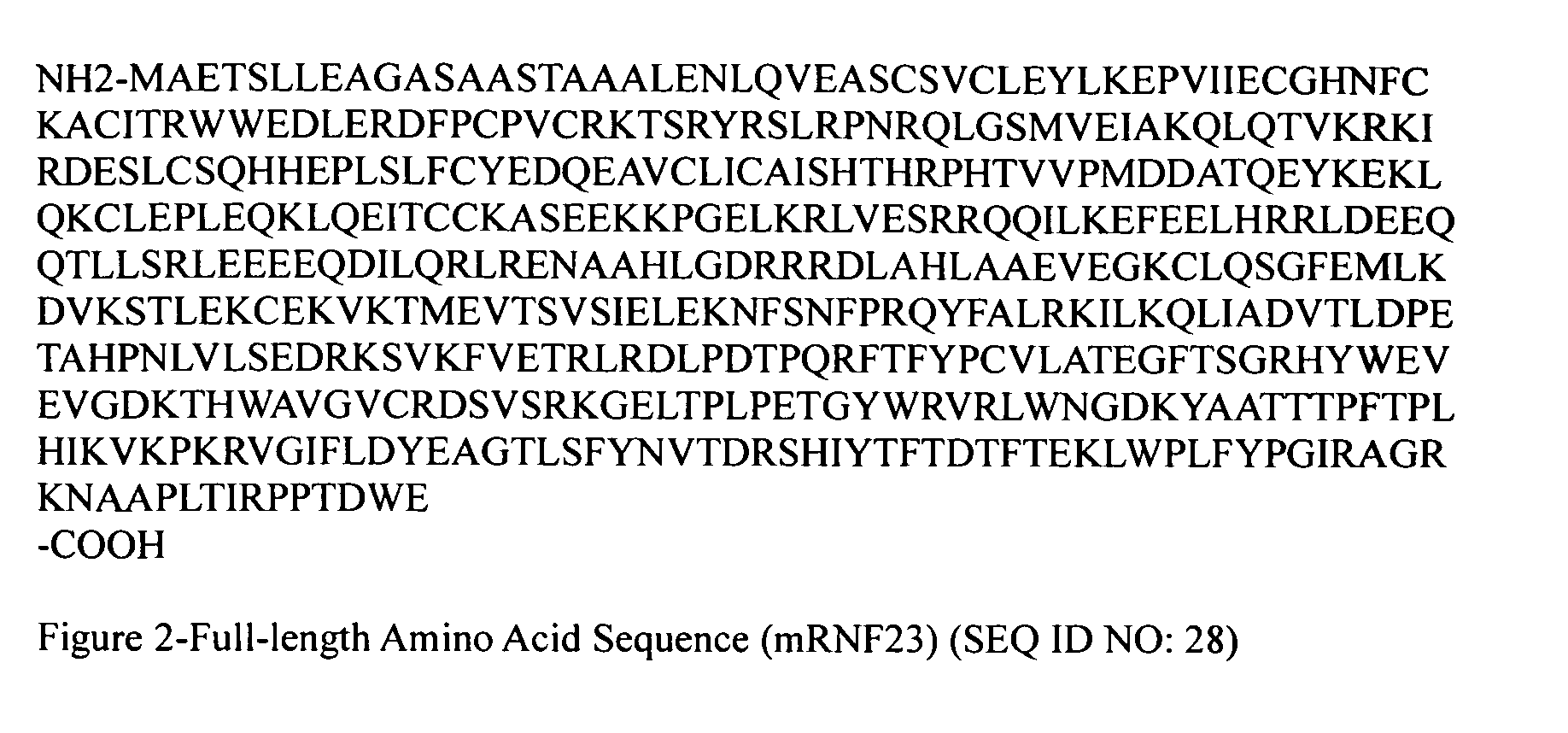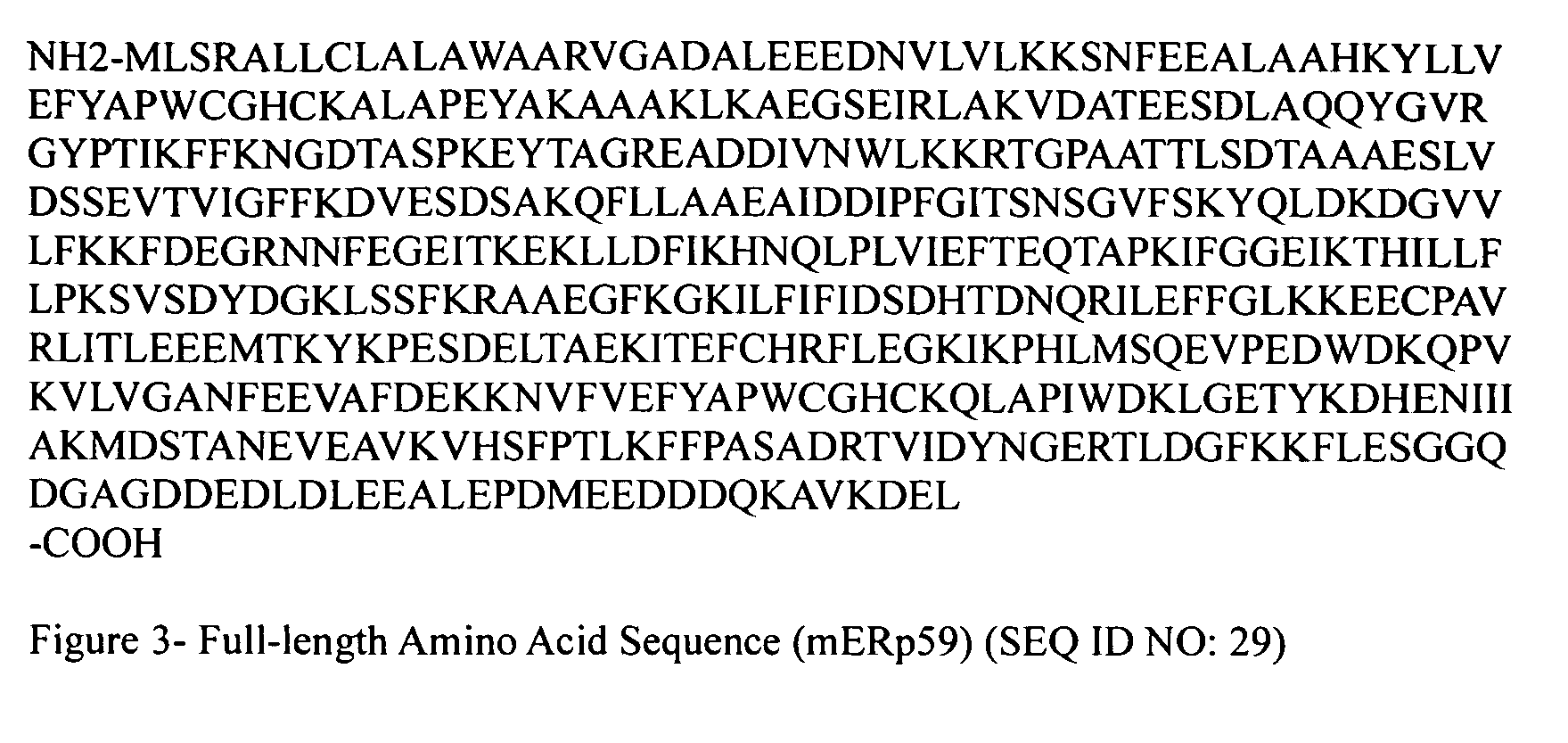[0018] In accordance with a second aspect of the invention, antibodies are provided which are immunoreactive with a protein complex of the present invention. In one embodiment, an antibody is selectively immunoreactive with a protein complex of the present invention. In another embodiment, a bifunctional antibody is provided which has two different antigen binding sites, each being specific to a different interacting protein member in a protein complex of the present invention. The antibodies of the present invention can take various forms including polyclonal antibodies, monoclonal antibodies, chimeric antibodies, antibody fragments such as Fv fragments, single-chain Fv fragments (scFv), Fab′ fragments, and F(ab′)2 fragments. Preferably, the antibodies are partially or fully humanized antibodies. The antibodies of the present invention can be readily prepared using procedures generally known in the art. For example, recombinant libraries such as phage display libraries and ribosome display libraries may be used to screen for antibodies with desirable specificities. In addition, various mutagenesis techniques such as site-directed mutagenesis and PCR diversification may be used in combination with the screening assays.
[0019] The present invention also provides detection methods for determining whether there is any aberration in a patient with respect to a protein complex having FHOS and one or more FHOS-interacting protein selected from the group consisting of GROUP1. In one embodiment, the method comprises detecting an aberrant level of the protein complexes of the present invention. Alternatively, the levels of one or more interacting protein members (at protein or cDNA or mRNA level) of a protein complex of the present invention are measured. In addition, the cellular localization, or tissue or organ distribution of a protein complex of the present invention is determined to detect any aberrant localization or distribution of the protein complex. In another embodiment, mutations in one or more interacting protein members of a protein complex of the present invention can be detected. In particular, it is desirable to determine whether the interacting protein members have any mutations that will lead to, or in disequilibrium with, changes in the functional activity of the proteins or changes in their binding affinity to other interacting protein members in forming a protein complex of the present invention. In yet another embodiment, the binding constant of the interacting protein members of one or more protein complexes is determined. A kit may be used for conducting the detection methods of the present invention. Typically, the kit contains reagents useful in any of the above-described embodiments of the detection methods, including, e.g., antibodies specific to a protein complex of the present invention or interacting members thereof, and oligonucleotides selectively hybridizable to the cDNAs or mRNAs encoding one or more interacting protein members of a protein complex. The detection methods may be useful in diagnosing a disease or disorder such as diabetes mellitus, cardiovascular disease, hypertension, nephropathy, acute and chronic inflammatory disorders, autoimmune diseases, cell proliferative disorders, cancers and neurodegenerative disorders, staging the disease or disorder, and identifying a predisposition to the disease or disorder.
[0020] The present invention also provides screening methods for selecting modulators of a protein complex formed between FHOS or a homologue, derivative or fragment thereof and an FHOS-interacting protein selected from the group consisting of GROUP1 or a homologue, derivative, or fragment thereof. Screen methods are also provided for selecting modulators of an FHOS-interacting protein selected from the group consisting of GROUP1. The compounds identified in the screening methods of the present invention can be used in modulating the functions or activities of FHOS, the FHOS-interacting proteins, or the protein complexes of the present invention. They may also be effective in modulating the cellular functions involving FHOS, FHOS-interacting proteins or FHOS-containing protein complexes, and in preventing or ameliorating diseases or disorders such as diabetes mellitus, cardiovascular disease, hypertension, nephropathy, acute and chronic inflammatory disorders, autoimmune diseases, cell proliferative disorders, cancers and neurodegenerative disorders. Thus, test compounds may be screened in an in vitro binding assay to identify compounds capable of binding a protein complex of the present invention or FHOS or an FHOS-interacting protein identified in accordance with the present invention or a homologue, derivative or fragment thereof. In addition, in vitro dissociation assays may also be employed to select compounds capable of dissociating the protein complexes identified in accordance with the present invention. An in vitro screening assay may also be used to identify compounds that trigger or initiate the formation of, or stabilize, a protein complex of the present invention. In preferred embodiments, in vivo assays such as yeast two-hybrid assays and various derivatives thereof, preferably reverse two-hybrid assays, are utilized in identifying compounds that interfere with or disrupt protein-protein interactions between FHOS or a homologue, derivative or fragment thereof and an FHOS-interacting protein or a homologue, derivative or fragment thereof. In addition, systems such as yeast two-hybrid assays are also useful in selecting compounds capable of triggering or initiating, enhancing or stabilizing protein-protein interactions between FHOS or a homologue, derivative or fragment thereof and an FHOS-interacting protein selected from the group consisting of GROUP1 or a homologue, derivative or fragment thereof.
[0021] In accordance with yet another aspect of the present invention, methods are provided for modulating the functions and activities of an FHOS-containing protein complex of the present invention, or interacting protein members thereof. The methods may be used in treating or preventing diseases and disorders such as diabetes mellitus, cardiovascular disease, hypertension, nephropathy, acute and chronic inflammatory disorders, autoimmune diseases, cell proliferative disorders, cancers and neurodegenerative disorders. In one embodiment, the methods comprise reducing the protein complex level and / or inhibiting the functional activities of the protein complex. Alternatively, the level and / or activity of FHOS or one of the FHOS-interacting proteins may be inhibited. Thus, the methods may include administering to a patient an antibody specific to a protein complex or FHOS or an FHOS-interacting protein, an antisense oligo or ribozyme selectively hybridizable to a gene or mRNA encoding FHOS or an FHOS-interacting protein, or a compound identified in a screening assay of the present invention. In addition, gene therapy methods may also be used in reducing the expression of the gene encoding FHOS or an FHOS-interacting protein.
[0022] In another embodiment, the method for modulating the functions and activities of an FHOS-containing protein complex of the present invention or interacting protein members thereof comprise increasing the protein complex level and / or activating the functional activities of the protein complex. Alternatively, the level and / or activity of one of the FHOS-interacting proteins or FHOS may be increased. Thus, a particular FHOS-containing protein complex, FHOS or an FHOS-interacting protein of the present invention may be administered directly to a patient. Or, exogenous genes encoding one or more protein members of an FHOS-containing protein complex may be introduced into a patient by gene therapy techniques. In addition, a patient needing treatment or prevention may also be administered with compounds identified in a screening assay of the present invention capable of triggering or initiating, enhancing or stabilizing protein-protein interactions between FHOS or a homologue, derivative or fragment thereof and an FHOS-interacting protein selected from the group consisting of GROUP1, or a homologue, derivative or fragment thereof.
[0023] The present invention also provides cell and animal models in which one or more of the FHOS-containing protein complexes identified in the present invention are in an aberrant form, e.g., increased or decreased level of the protein complexes, altered interaction between interacting protein members of the protein complexes, and / or altered distribution or localization (e.g., in organs, tissues, cells, or cellular compartments) of the protein complexes. Such cell and animal models are useful tools for studying the disorders and diseases caused by the protein complex aberrations and for testing various methods for treating the diseases and disorders.
 Login to View More
Login to View More 


